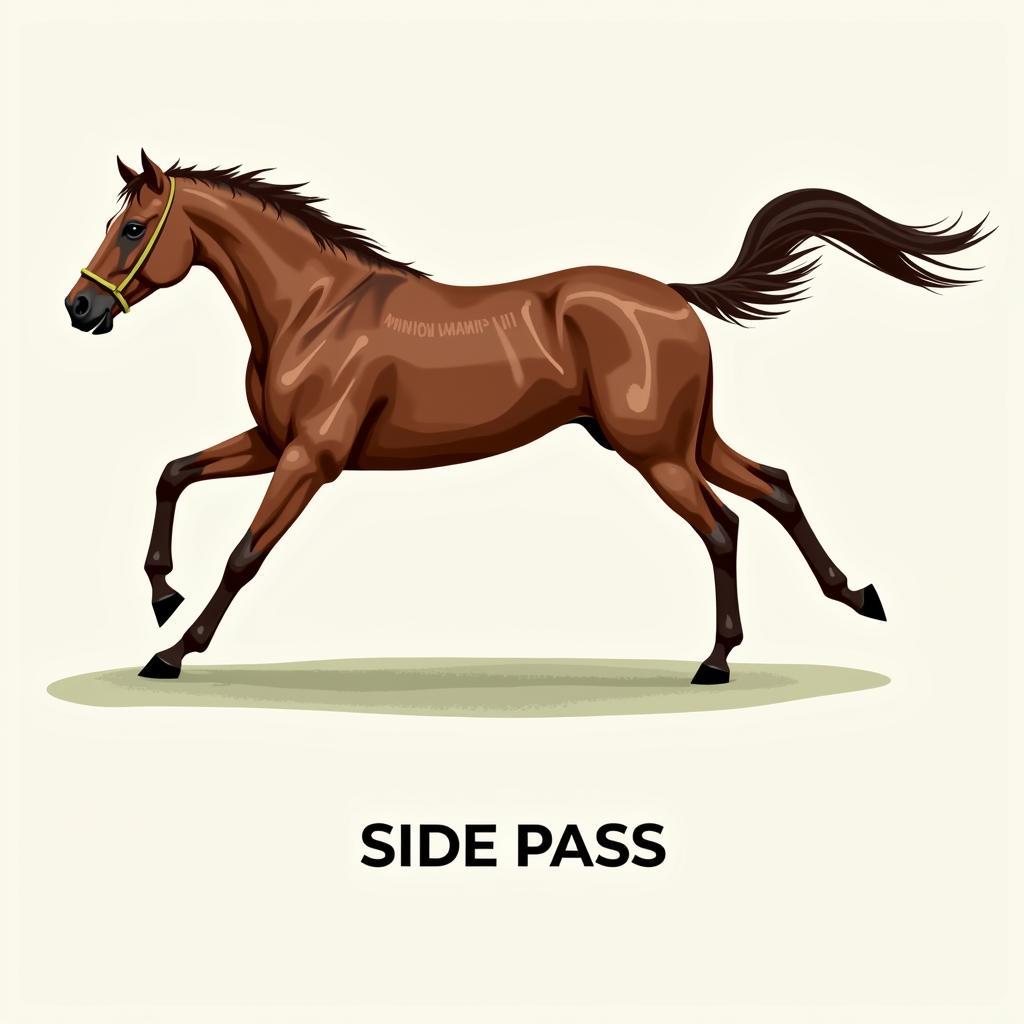The Side Pass Horse maneuver is a fundamental skill in various disciplines, from Western riding to classical dressage. It’s a test of communication, control, and partnership between horse and rider. This comprehensive guide will delve into the intricacies of teaching and executing the perfect side pass, covering everything from basic principles to advanced techniques.  Horse Demonstrating a Precise Side Pass
Horse Demonstrating a Precise Side Pass
Understanding the Mechanics of the Side Pass
The side pass requires the horse to move laterally, stepping sideways while maintaining a straight body posture. It’s not simply a matter of drifting sideways; the horse should cross its legs in a controlled and rhythmic manner, demonstrating collection and responsiveness to the rider’s aids. This controlled movement strengthens the horse’s hindquarters, improves balance, and refines coordination. It’s crucial for developing suppleness and preparing for more advanced maneuvers. Remember, the goal is not speed, but precision and control.
A common mistake is allowing the horse to swing its hindquarters inward or lead with the front end. The horse should remain straight, moving its legs in a coordinated four-beat sequence. Imagine drawing a straight line along the horse’s spine; this line should remain parallel to the direction of travel.
Are you looking for a unique gift for the horse lover in your life? Check out our collection of horse charms.
Training Your Horse for the Side Pass: A Step-by-Step Approach
- Preparation: Begin by ensuring your horse understands basic yielding to leg pressure. This can be achieved through exercises like leg yielding and turning on the forehand.
- Introducing the Side Pass: Position your horse parallel to a fence or wall. Apply gentle leg pressure at the girth, asking the horse to step sideways. Use your reins to maintain a straight body posture, preventing the horse from turning or swinging its hindquarters.
- Reinforcing Correct Movement: Reward even the smallest attempt at a correct side pass. Release the pressure the moment your horse steps sideways in the desired direction. Consistency and positive reinforcement are key to successful training.
- Increasing the Difficulty: As your horse progresses, gradually increase the distance of the side pass and introduce variations, such as side passing over poles or across the arena.
What about keeping warm in the stables? A horse sweater women’s is just the thing.
Common Challenges and Troubleshooting
- Horse Leaning on the Rein: This often indicates the horse is relying on the rein for balance rather than engaging its hindquarters. Focus on using your legs effectively and maintaining a soft, consistent rein contact.
- Overbending or Swinging the Hindquarters: Ensure your outside leg is positioned slightly behind the girth to prevent the hindquarters from swinging inward. Use your inside rein to maintain a straight body posture.
- Resistance or Confusion: Break the exercise down into smaller steps and revisit the basics of yielding to leg pressure. Patience and clear communication are crucial for overcoming resistance.
“Patience and consistent training are paramount when teaching the side pass. Remember to reward even the smallest try and break the exercise down into manageable steps.” – Dr. Emily Carter, Equine Veterinarian and Trainer
Fine-tuning the Side Pass for Advanced Performance
Once your horse understands the basics, you can refine the side pass by focusing on collection, cadence, and precision. This involves developing the horse’s ability to maintain a steady rhythm, cross its legs evenly, and respond to subtle shifts in your weight and leg aids.  Close-Up of Horse's Legs During Side Pass
Close-Up of Horse's Legs During Side Pass
Need a decorative touch for your home? Consider a beautiful horse drawn carriage ornament.
Conclusion: The Art of the Side Pass
The side pass is more than just a maneuver; it’s a testament to the harmonious partnership between horse and rider. By mastering this fundamental skill, you’ll not only improve your horse’s athleticism and responsiveness but also deepen your connection and communication. With patience, consistent training, and a focus on clear communication, you can unlock the true potential of the side pass and elevate your riding to a new level.
“A well-executed side pass showcases the horse’s athleticism and the rider’s skillful communication, demonstrating a true partnership built on trust and understanding.” – John Miller, Professional Horse Trainer
Looking for natural horse care solutions? Consider our silver lining horse herbs. And for personalized equestrian accessories, explore our range of embroidery horse options.
Need help with training? Contact us! Phone: 0772127271, Email: [email protected] Or visit us at: QGM2+WX2, Vị Trung, Vị Thuỷ, Hậu Giang, Việt Nam. We have a 24/7 customer support team.